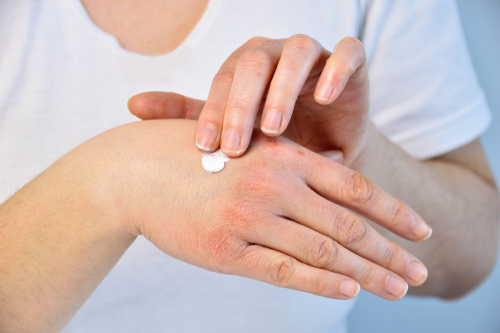Gentamicin Promotes Wound Closure in Severe JEB Patients, Phase 1/2 Trial Shows

When applied directly over skin wounds, the antibiotic gentamicin can restore the production of laminin 332 and promote wound closure in people with generalized severe junctional epidermolysis bullosa (GS-JEB), a Phase 1/2 trial shows.
The findings were reported in the study “Gentamicin Induces Laminin 332 and Improves Wound Healing in Junctional Epidermolysis Bullosa Patients with Nonsense Mutations,” published in the journal Molecular Therapy.
Laminin 332 is an essential component of the dermal-epidermal junction (DEJ), the region where the outermost layer of the skin (epidermis) is attached to an inner skin layer (dermis). This structure is particularly important for skin integrity and to ensure its resistance against mechanical forces.
GS-JEB is a skin disorder caused by mutations in one of three genes — LAMA3, LAMB3, or LAMC2 — that provide instructions for making three chains of laminin 332 required for its normal skin anchoring function.
Most of these mutations are nonsense mutations, in which an alteration in a single nucleotide of the gene’s DNA sequence leads to the introduction of a stop codon and to the production of a shorter and non-functional version of laminin 332. Nucleotides are the building blocks of DNA, and codons are sequences of three nucleotides that encode one amino acid (the building blocks of proteins).
A previous study suggested that gentamicin is able to render these nonsense mutations ineffective by preventing cell components from recognizing the stop codon in the gene’s DNA sequence. By doing so, gentamicin can restore the production of a functional, normal-size protein in skin cells.
In the new study, the same team reported early findings of an ongoing Phase 1/2 trial (NCT03526159) that is exploring gentamicin’s therapeutic potential at restoring the production of laminin 332 and promoting wound healing in GS-JEB patients. The study is being conducted at University of Southern California and is still enrolling.
Analyses included data from three patients, ages 1–9, who carried at least one nonsense mutation in LAMA3 or LAMB3. They were recruited from August 2018 to June 2019.
The study has two main goals: assessing gentamicin’s safety when applied topically over skin wounds, and evaluating the antibiotic’s ability to restore laminin 332 levels in the DEJ of selected skin wounds.
Gentamicin’s efficacy was first tested in keratinocytes — skin cells that make up about 90% of all cells found in the epidermis — isolated from the three participants and cultured in a lab dish.
Results showed that gentamicin was able to induce the production of laminin 332, reversing the abnormal morphology and restoring the ability of cells to attach to the bottom of the dish — suggesting improved skin attachment.
Then, the team started applying an ointment containing 0.5% of gentamicin directly over open skin wounds in all three patients to assess if the antibiotic could promote the production of laminin 332 and wound closure.
Specifically, gentamicin was applied topically over three selected skin wounds, twice-a-day, for a period of two weeks. Skin biopsies taken before treatment and one and three months after were analyzed with a technique called immunofluorescence to assess the levels of laminin 332 in skin wounds.
Although responses varied, the researchers found that all patients responded to treatment, with gentamicin increasing laminin 332 levels from baseline (study start) to three months after treatment.
Topical treatment with gentamicin also promoted wound closure, with all treated wounds being fully healed within three months. No side effects associated with treatment were identified during the study.
“Our study demonstrated that gentamicin suppression of nonsense mutations in GS-JEB patients can restore sufficient levels of functional laminin 332 and improve wound healing,” the investigators wrote.
Future goals for the researchers include determining “the dose of gentamicin, administration route, and frequency of gentamicin delivery that optimizes the generation of laminin 332 in the skin of GS-JEB patients. We will also determine whether gentamicin administered systemically to these patients can treat all skin wounds simultaneously, as well as address [other] manifestations of GS-JEB including often life-threatening involvement of the respiratory tract.”
The investigators added that gentamicin’s ability to suppress the effects of stop codons may be beneficial in other inherited skin conditions also associated with nonsense mutations.






